Tips for shooting on rainy days
In the last article we looked at ideas of all the great things you can photograph on rainy days. In this article we'll look at some tips on how to combat certain problems that the rain brings (such as keeping your camera dry).
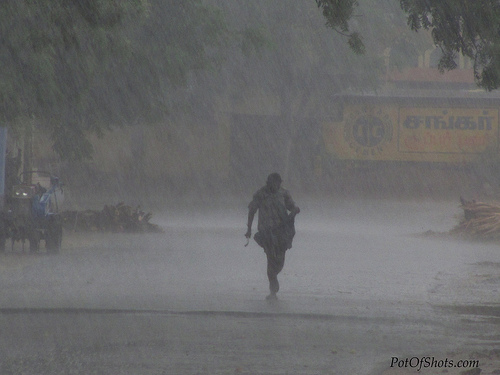
Running for cover by Joseph Jayanth on flickr (licensed CC-BY)
The main problem when shooting in the rain is that you don't want your camera to get wet. The vast majority of cameras can survive a little rain okay. More expensive weather sealed cameras, such as the Pentax K-30, can survive harsher weather, but even so, it is still best to keep your camera as dry as possible.
Use a lens hood
Using a lens hood on your camera / lens is almost essential if you are shooting in the rain. Unless you are shooting up at an angle, it will stop rain drops from hitting the front element of the lens.
This is particularly important if you are shooting with a wide-angle lens, as any droplets on the lens are more likely to show up in images. Unfortunately lens hoods for wide-angle lenses by necessity have to be quite shallow, but they still provide some degree of protection.
If you are using a telephoto lens, water on the front of the lens isn't likely to show up as visible droplets in images, but image quality will still be affected somewhat. So use a lens hood to protect the front of the lens from rain.
Use an Umbrella
Using an umbrella to protect yourself and your camera from the rain is a good idea. Shooting handheld, holding the umbrella while also using your camera can be quite tricky, but here are a couple of tips:
If you have an umbrella with a crook handle, wedge the handle between your arm and the side of your body. This only works with crook handled umbrellas as a straight handle would be likely to slip. By keeping the handle pressed against your body and supporting the shaft with your forearm, you should be able to keep the umbrella steady while having both your hands free to operate the camera.
For straight handled umbrellas, you can place the handle in a pocket, and then press the umbrella shaft against your chest with your arm as you hold the camera to your face. Depending on the length of your umbrella's shaft, you will probably need to wear a shirt with a front pocket for this technique.
If you use a monopod, or a tripod with an extending center column, you can try clamping an umbrella to the monopod or center column. You can purchase purpose-made rain umbrella holders, such as this one: Golfers Club Trolley Universal Umbrella Holder (suitable for tripods / monopods with a center column not more than 3 cm thick).
Or alternatively you can create your own umbrella holder using various clamps. One umbrella holder that used to be commercially available (now discontinued it seems) was actually comprised of a Falcon Eyes CL-35 C-Clamp with Spigot and a Falcon Eyes CL-35F C-Clamp with Spigot Holder. A solution used by quite a few photographers is two Manfrotto Super clamps joined together by a spigot. You can see an example of this here: Baron's Manfrotto/Bogen SuperClamps Rain set-up.
And another popular choice seems to be a Manfrotto Super clamp with an Avenger Add-A-head. (Unlike the other solutions the Add-a-head clamps onto the umbrella shaft rather than the handle).
If you do clamp an umbrella to your tripod or monopod, just make sure there isn't any wind. You don't want a gust of wind catching the umbrella, then pulling the tripod over and smashing your camera to the ground.
Another umbrella option is an Umbrella hat. This is like an umbrella with no shaft that has a couple of straps so you can secure it your head and wear it as a hat. Likely wearing one of these will draw quite a bit of attention to you, so it's probably not a great idea for street photography. But providing you get one that's large enough, it should keep you and your camera relatively dry.
One important thing to mention about all forms of umbrellas is that you should not use them during a thunderstorm. They act just like a lightning rod, so it is better to get a bit wet than risk getting fried by a lightning strike.
An unusual use for an umbrella can be to include it as part of your photo. This will work best if you are using quite a wide angle lens. Just tilt the umbrella down a bit so that it covers the top edge of your photo.
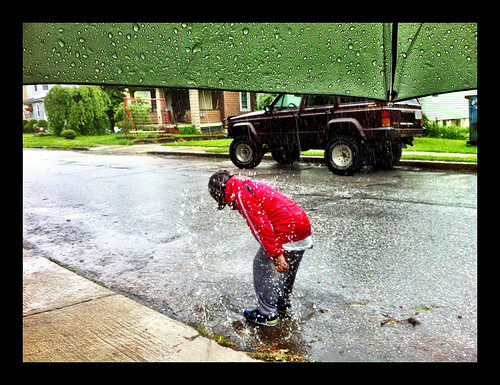
grownups hate the rain because we forget how to do this. by Urban Hippie Love on flickr (licensed CC-BY-SA)
Bag up your camera
To keep your camera from getting wet, you can enclose it in a waterproof bag or sleeve. There are quite a few different companies that make rain covers for cameras, one that often seems to be recommended are the Storm Jacket Camera Covers. Basically these are just bags with holes at both ends that slip over your camera. The hole at one end lets the camera's lens peek out, while the hole at the other end lets you still see through the camera's viewfinder and use all the controls.
A much cheaper (though not as hard-wearing) alternative is to just use a standard plastic bag (or a zip-lock bag would be even better). Cut a hole in the other end. Then use a rubber band to attach one end round the lens hood while the rest of the bag covers the camera.
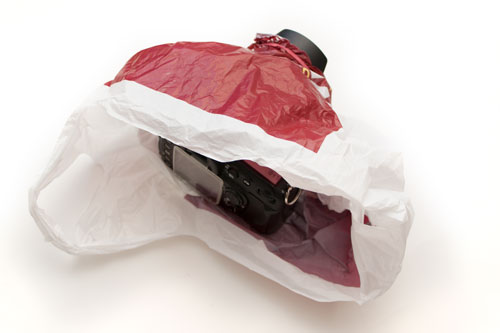
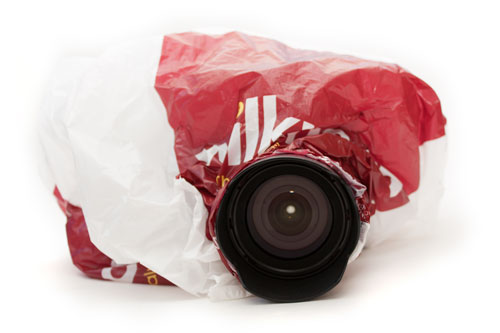
Bring a towel
If your gear does get wet, then having a towel to dry it off is a good idea. Make sure it is a soft towel. A lens cloth can also come in handy for wiping away any raindrops that do make it to the front of your lens.
Remember to check the lens for raindrops every so often. You don't want to keep shooting away and then later find half the photos have a raindrop on the lens.
Find shelter
If you don't have an umbrella, or it's not safe to use an umbrella, then try and find some shelter if you can. In towns and cities you can often shelter under covered walk ways. Trees can provide some shelter in both the city and countryside.
Shooting out of your car, and using your car as a shelter can work well too. Though how interesting your shots turn out will depend partly on where you are parked.
Waterproof your Camera bag
Carrying gear around with you in a camera bag, you need to make sure the contents of the bag don't get wet. Most camera bags could probably claim to be splash proof, but when it's raining they really need to be covered up in a waterproof cover.
Quite a few camera bags come with rain covers included. Usually the cover will be folded up in a small compartment at the bottom or the back of the bag, then can be pulled out to cover up the whole bag.
If your bag doesn't include a waterproof cover, you can buy backpack rain covers separately. Just make sure you get one that is the right size for your bag. The only problem with waterproof covers is that you can't easily access your gear when the cover is on. But it's better than your gear getting all wet.
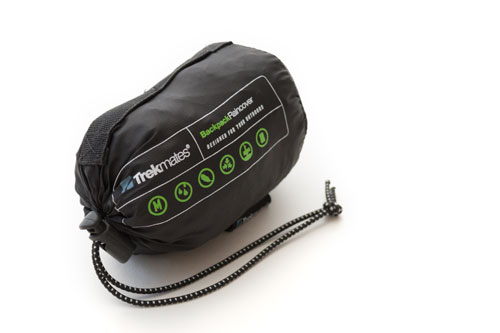
Mind your shutter speed
Rain clouds are almost always thick and heavy, so they don't let a lot of light through. Because of the lack of light, your camera may choose to use a relatively slow shutter speed to compensate. If you are hand holding the camera or photographing movement, make sure that the shutter speed is fast enough to avoid problems with blur.
Using a higher ISO or large aperture setting e.g. f/2.8 lets more light into the camera so you can use a faster shutter speed. Alternatively using a tripod or monopod will help you keep the camera steady at longer shutter speeds.
Lastly, when shooting in the rain, remember to keep yourself as dry as possible as well as your camera. Wear a waterproof jacket or poncho. Gaiters and waterproof over trousers are recommended if you'll be photographing in rain all day. It's not worth catching pneumonia just to get a few photos in the rain, make sure you are dressed properly.





You can’t catch pneumonia by getting cold or wet. In fact, you can’t catch it at all. It is an old-wive’s tale. You cannot even catch a cold that way.